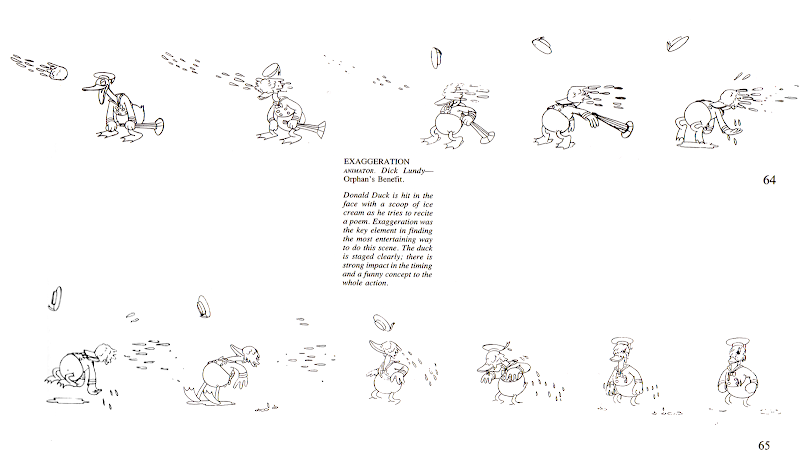TIMING
Expertise in timing comes best with experience and personal experimentation, using the trial and error method in refining technique. The basics are: more drawings between poses slow and smooth the action. Fewer drawings make the action faster and crisper. A variety of slow and fast timing within a scene adds texture and interest to the movement. Most animation is done on twos (one drawing photographed on two frames of film) or on ones (one drawing photographed on each frame of film). Twos are used most of the time, and ones are used during camera moves such as trucks, pans and occasionally for subtle and quick dialogue animation. Also, there is timing in the acting of a character to establish mood, emotion, and reaction to another character or to a situation. Studying movement of actors and performers on stage and in films is useful when animating human or animal characters. This frame by frame examination of film footage will aid you in understanding timing for animation. This is a great way to learn from the others.
and
EXAGGERATION
Exaggeration is not extreme distortion of a drawing or extremely broad, violent action all the time. It's like a caricature of facial features, expressions, poses, attitudes and actions. Action traced from live action film can be accurate, but stiff and mechanical. In feature animation, a character must move more broadly to look natural. The same is true of facial expressions, but the action should not be as broad as in a short cartoon style. Exaggeration in a walk or an eye movement or even a head turn will give your film more appeal. Use good taste and common sense to keep from becoming too theatrical and excessively animated
See the book "Character Animation Crash Course" by Eric Goldberg , Chapter 8 TIMING.
Also, if you have it , see the book "Disney Animation: The Illusion of Life" by Frank Thomas and Ollie Johnston, in the chapter on the Principles of Animation. They discuss Timing in depth . At one point they give an example of how many drawings used to show an action will effect how the viewer perceives the action (the TIMING) , talking about animating a character's head turning from right to left:


(just a few short years later the animators at Warner Brothers and MGM would push the Speed (timing) and Exaggeration of this kind of action to much greater extremes, to make this kind of action much more violent . Numerous examples could be shown : see various Warner Bros. shorts from the 1940's and 50's , and MGM's shorts in the 40's and 50's directed by Tex Avery and Bill Hanna & Joseph Barbera ["Tom & Jerry"] for examples of how far the timing of this kind of violent slapstick action could be pushed)
Another example of Exaggeration , as Joey, the hippo, inhales and blows out the candles on Tillie's birthday cake in "Elmer the Elephant" -
Finally here's an example of Exaggeration , showing a character who is literally frozen being warmed up by a pretty girl rabbit's kiss . This kind of gag showing a stylized visual representation of the character's inner feelings is something uniquely suited to animation . It's not realistic at all , but it has BELIEVABILITY thorough the sincerity of the accomplished animation:
*Keeping in mind Frank and Ollie's example above of how the number of drawings used effects the timing of the action, there is a great example cited by Richard Williams in his book "The Animator's Survival Kit" on page 99 under "The Major Beginner's Mistake" . This is the example of Ben Washam's "famous 12 frame yawn". Look it up in the book. Rather than recount the story, I'll post a video of Richard Williams explaining it :
*Ben Washam developed into one of the finest animators at Warner Bros. Cartoon Studio (or anywhere else !) , but this story about his experience as a new animator is something that most of us can relate to.

Excellent technical video explaining the basics of TIMING and SPACING:
-------
A few more things about EXAGGERATION:
Animator Tahsin Özgür, has a good demonstration of how different animation styles ("worlds") demand varying degrees of EXAGGERATION . (for example: if you were animating a somewhat realistic human character like Roger Radcliffe from "One Hundred and One Dalmatians" you wouldn't animate him with the same degree of EXAGGERATION as Roger Rabbit . ) The degree of exaggeration in the animation must be appropriate for the world the character inhabits.
https://vimeo.com/90952125
"Exaggeration is essential to animation, but the degree of exaggeration differs according to the animation universe you choose to create. Here I interpret the same episode in two different styles, one in a more restrained style, in a comparatively restrained animation universe, the secand is more "cartoony", where more liberties are allowed."
.
No comments:
Post a Comment
Note: Only a member of this blog may post a comment.